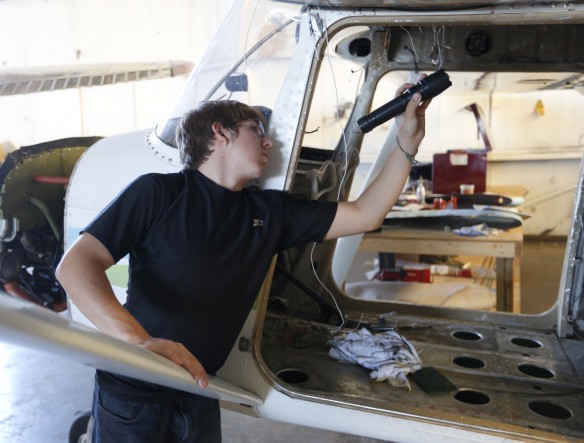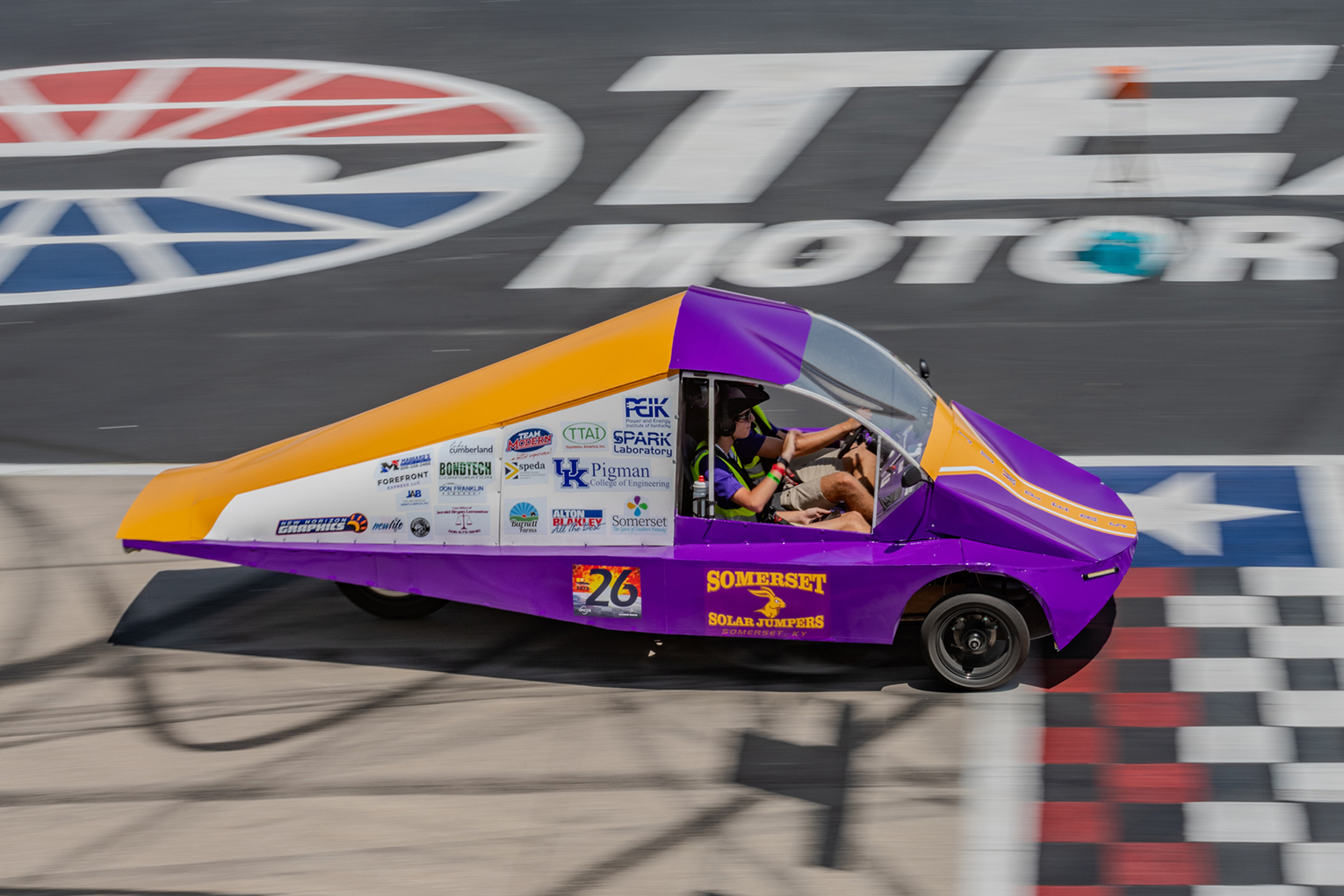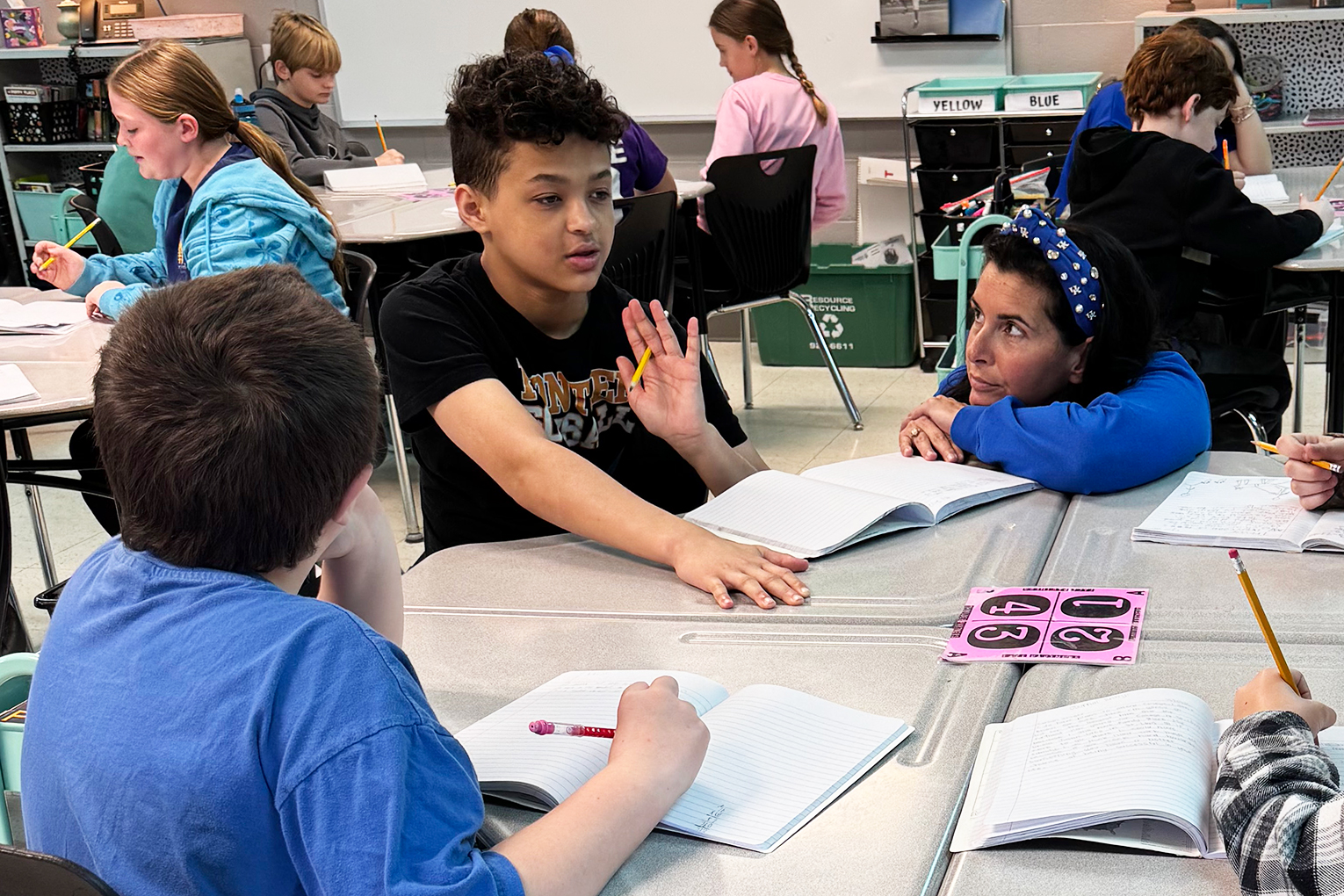
Tristan Hamilton, a student at Henry County High School, works on an airplane at The National Air & Space Education Institute at Bowman Field in Louisville.
Photo by Mike Marsee, Sept. 22, 2015
By Michael Marsee
michael.marsee@education.ky.gov
The sky is the limit in the booming aerospace industry in Kentucky, and Tim Smith is helping students get a head start toward its lucrative careers.
Students participating in an Air & Space Academy – a program created by the Louisville-based National Air and Space Education Institute – can have a private pilot’s license in hand by the time they graduate high school. They also can begin learning to build or repair aircraft, become air traffic controllers or design nanosatellites.
Smith, a licensed pilot and former teacher who is the executive director of the institute, offers those options and others to teachers and students through his nonprofit educational organization. The organization partners with schools, airports, flight schools, aviation and aerospace organizations and corporations to provide an engaging STEM curriculum that can prepare high school students to work in a growing field.
The National Air and Space Education Institute was established in 2010 by Smith, a licensed pilot and former mathematics teacher. He used a program that was already in place at Frankfort High School (Frankfort Independent) and Capital City Airport in Frankfort as a prototype, then began building a network of schools.
The program is based at Bowman Field, but its reach goes far beyond the former Army Reserve hangar it occupies at that Louisville airport. The academy’s curriculum is being taught in 40 school districts in Kentucky, a number that has roughly doubled in the past year, and four in Tennessee
“It’s pretty exciting stuff the kids get to do in high school, and it gets them connected to the industry while they’re in high school,” Smith said.
Students from the program’s formative years – the Frankfort High program got off the ground in 2005 after Smith introduced aviation topics into his mathematics classes – are already flying commercial and military aircraft and working in related fields. And more students are starting down one of the program’s nine career pathways, which include working toward a pilot’s license as well as maintenance, engineering, unmanned aerial systems and aviation business.
It is an approved course of study for career and technical education that engages students from their freshman year through graduation. It can offer dual credit as well.
“This is the only model like this of its kind in the whole nation,” Smith said.
The program completed a move earlier this year into Bowman Field’s 40,000-square foot Hangar 7, where all but one of its 15 aircraft are housed and where the process of creating classroom and laboratory space is ongoing.
There are students studying there, primarily from schools that do not offer an academy on their campus. Most students in the academies are taught by teachers in their local schools, with help from the pilots, maintenance technicians and others at local airports.
“That’s what the school leans on, because we don’t have pilots. If I told them they had to hire a pilot, the superintendents would laugh at me. We do this through the STEM teachers, but we facilitate it through the airport. The airport and the school partner up and we provide more support as well,” Smith said.
Schools develop their own labs for the career pathways they choose to offer, which can include flight simulators, wind tunnels and other equipment. Teachers come to Bowman Field in the summer for a three-day professional development.
“We train teachers in the summer time to facilitate the labs, and we deliver the course content through technology,” Smith said.
Some of that content was developed by Mike Wagers, a pilot and Federal Aviation Administration-certified flight instructor who is the aerospace teacher at Frankfort High School. Wagers uses the same classroom where aeronautics classes began being taught in 1946. The current program at Frankfort High includes five career pathways, including a dozen or so students from nearby Franklin County and Western Hills (Franklin County) and Anderson County high schools.
Frankfort High has a high percentage of free- and reduced-lunch students. Wagers said many of them “would never think that an aerospace career would be for them,” but more and more doors are opening every day in that industry.
Wagers said Gov. Steve Beshear announced in 2014 that the aerospace industry had surpassed the automotive industry as the largest contributor to the Commonwealth’s gross domestic product — $7.8 billion. Wagers said it’s important to train people to fill the jobs that are being added.
“If it’s Kentucky jobs that are being created, we want Kentucky residents to take those positions,” Wagers said.
Smith said students participating in an Air & Space Academy will be well equipped to take those positions – and even sooner than many of their peers.
“The data we’ve seen is that our kids are college- and career-ready by the end of their 11th-grade year,” he said.
Many of the students who are introduced to the program are enthralled by the idea of learning to fly, but that’s only one of the options available.
“Everybody comes in and thinks they want to be a pilot,” Wagers said. “That’s why that freshman year, we don’t allow them to focus on anything.”
Ashton Brooks, a sophomore at Henry County High School, said he wasn’t sure whether he wanted to fly planes or work on them when he first heard about the class.
“I wanted to do mechanics because I thought it would be easier, but I wanted to do flying because it’s my passion. So I decided not to take the easy route out and go after my passion,” Brooks said. “I want to fly for UPS one day, but first things first, I’ve got to get my private pilot’s license. I wanted to get it early so I could try to get on at UPS at 30 or a little bit before, so I can get an early start.”
Jacob Alvey did that, spending three years in the program before graduating from Oldham County High School in 2011. He graduated from the University of North Dakota, one of the top aviation schools in the country, this spring and is training to fly for Air Wisconsin Airlines, an American Eagle affiliate.
Alvey, who visited Smith at Bowman Field recently, said he wouldn’t have been so far along if it hadn’t been for the training he got while still in high school, including the hundreds of cockpit hours he got before college.
“I was the youngest person in my airline class by three years. From the very beginning, I started working on learning things and building fundamentals, so when I got to college it was easy,” he said.
Another Henry County High student, Tristan Hamilton, said he has been attracted to aviation since playing with model airplanes as a child. He is more interested in working on planes than flying them, so he is studying aircraft maintenance.
“I’ve always taken things apart and tried to figure out how to put them back together, how they work,” he said.
Hamilton said he hopes to have half of the work toward his airframe and powerplant license certification complete while still in high school, then finish that work in college.
Henry County High does not offer an Air & Space Academy, but does allow its students to come to Louisville to study in the program. Hamilton and Brooks said they come to Louisville about three days a week, sometimes just to hang around the hangar if they don’t have a specific assignment.
On this day, Brooks’ assignment was to create a flight plan between two Kentucky airports. He said such work involves doing the same kinds of problems he might do in a typical mathematics class, “but it’s a lot more fun.”
The fun also includes a wing design competition that began Oct. 1 and will culminate with a statewide showcase in May at the Somerset airport.
Wagers said his program at Frankfort High has a 100 percent graduation rate. He said two of his students were formerly home-schooled, but chose to enroll at Frankfort to be part of the program.
He also said he loves to see students challenged by the program.
“The smart kid, when everything comes easy to them, they get in here and realize that, ‘I’ve got to study for this,’ and it becomes challenging to them. They like it because they’re not bored anymore,” Wagers said.
Smith said he loves to hear from teachers such as Deanna Cummins, a mathematics and aerospace teacher at Williamstown High School (Williamstown Independent), whose school adopted the academy curriculum this year.
“My students are loving this class,” Cummins wrote in an email to Smith. “It’s amazing to see them want to learn. The connections they have made to mathematics is wonderful. I have 26 or 27 students in aerospace that are also in my math classes, so we’re able to make many, many connections. It’s going really well.”
“It’s amazing to see those first-year teachers excited,” Smith said. “That’s the way education is supposed to be. Teachers are supposed to be energetic, and I think this concept allows teachers to be reinvigorated.”
MORE INFO …
National Air and Space Education Institute/Air & Space Academy
Tim Smith tim@airandspace-ed.org
Mike Wagers mike.wagers@frankfort.kyschools.us







Leave A Comment